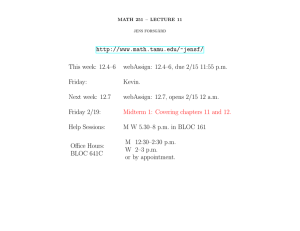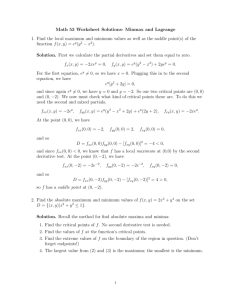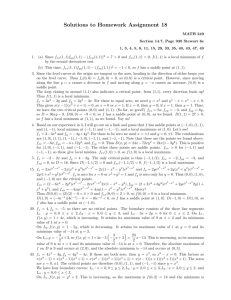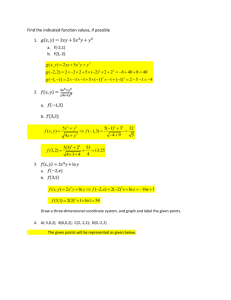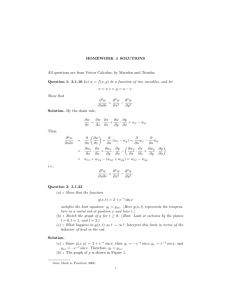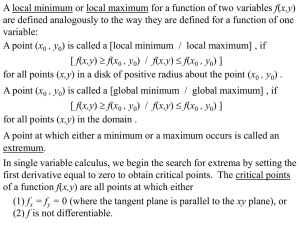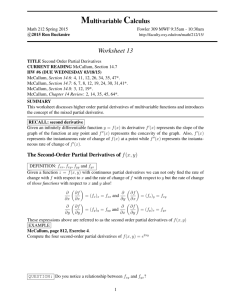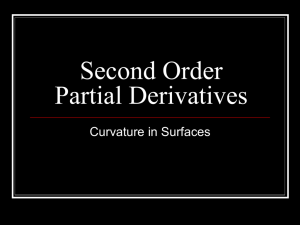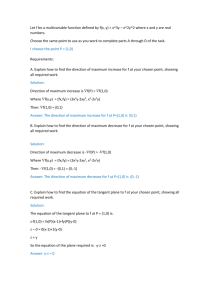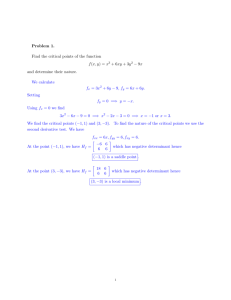SOLUTIONS TO HOMEWORK ASSIGNMENT #5, Math 253
advertisement
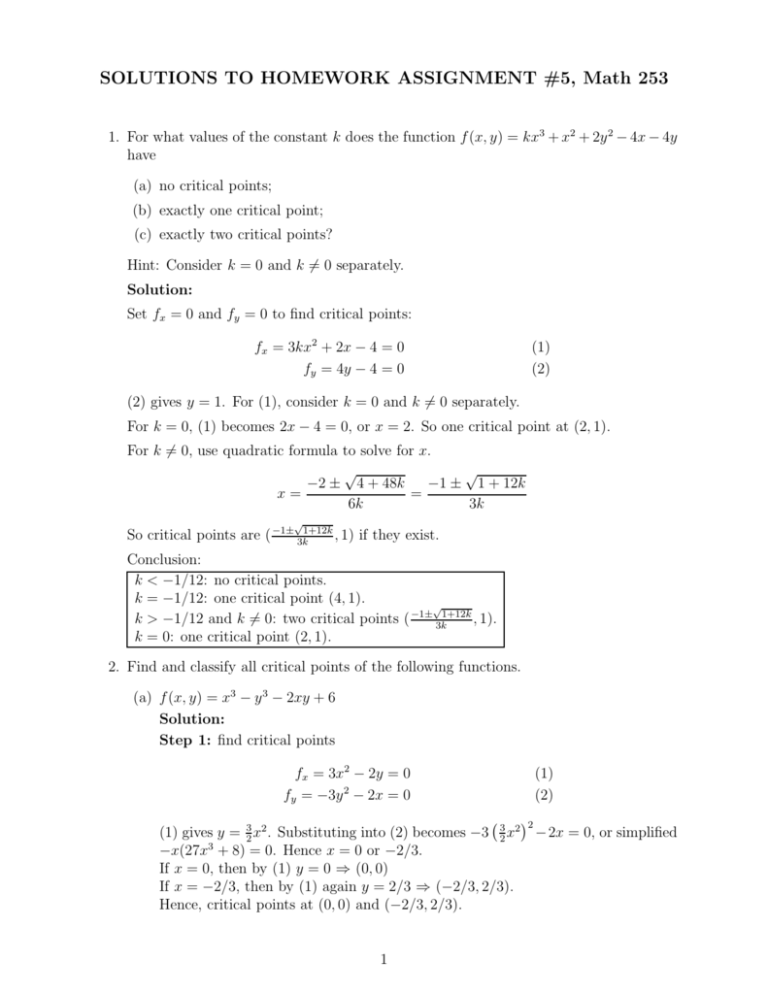
SOLUTIONS TO HOMEWORK ASSIGNMENT #5, Math 253
1. For what values of the constant k does the function f (x, y) = kx3 + x2 + 2y 2 − 4x − 4y
have
(a) no critical points;
(b) exactly one critical point;
(c) exactly two critical points?
Hint: Consider k = 0 and k 6= 0 separately.
Solution:
Set fx = 0 and fy = 0 to find critical points:
fx = 3kx2 + 2x − 4 = 0
fy = 4y − 4 = 0
(1)
(2)
(2) gives y = 1. For (1), consider k = 0 and k 6= 0 separately.
For k = 0, (1) becomes 2x − 4 = 0, or x = 2. So one critical point at (2, 1).
For k 6= 0, use quadratic formula to solve for x.
√
√
−2 ± 4 + 48k
−1 ± 1 + 12k
x=
=
6k
3k
√
So critical points are ( −1± 3k1+12k , 1) if they exist.
Conclusion:
k < −1/12: no critical points.
k = −1/12: one critical point (4, 1).
√
k > −1/12 and k 6= 0: two critical points ( −1± 3k1+12k , 1).
k = 0: one critical point (2, 1).
2. Find and classify all critical points of the following functions.
(a) f (x, y) = x3 − y 3 − 2xy + 6
Solution:
Step 1: find critical points
fx = 3x2 − 2y = 0
fy = −3y 2 − 2x = 0
(1) gives y = 32 x2 . Substituting into (2) becomes −3 32 x2
−x(27x3 + 8) = 0. Hence x = 0 or −2/3.
If x = 0, then by (1) y = 0 ⇒ (0, 0)
If x = −2/3, then by (1) again y = 2/3 ⇒ (−2/3, 2/3).
Hence, critical points at (0, 0) and (−2/3, 2/3).
1
(1)
(2)
2
−2x = 0, or simplified
Step 2: apply second derivative test
fxx = 6x fyy = −6y
fxy = −2
At (0, 0), fxx = 0, fyy = 0, fxy = −2. So D = fxx fyy − (fxy )2 = −4 < 0 ⇒ saddle
At (−2/3, 2/3), fxx = −4 < 0, fyy = −4, fxy = −2. So D = 12 > 0 ⇒ local max
Hence, local max at (−2/3, 2/3), saddle point at (0, 0)
(b) f (x, y) = x3 + y 3 + 3x2 − 3y 2 − 8
Solution:
Step 1: find critical points
fx = 3x2 + 6x = 0
fy = 3y 2 − 6y = 0
(1)
(2)
We can solve the two equations separately. (1) gives x = 0 and −2. (2) gives
y = 0 and 2. Hence, there are four critical points at (0, 0), (0, 2), (−2, 0), and
(−2, 2).
Step 2: apply second derivative test
fxx = 6x + 6 fyy = 6y − 6 fxy = 0
At
At
At
At
(0, 0), fxx = 6, fyy = −6, fxy = 0, so D = −36 < 0 ⇒ saddle
(0, 2), fxx = 6 > 0, fyy = 6, fxy = 0, so D = 36 > 0 ⇒ local min
(−2, 0), fxx = −6 < 0, fyy = −6, fxy = 0, so D = 36 > 0 ⇒ local max
(−2, 2), fxx = −6, fyy = 6, fxy = 0, so D = −36 < 0 ⇒ saddle
Hence, local max at (−2, 0), local min at (0, 2), saddle at (0, 0) and (−2, 2)
(c) f (x, y) = x2 +y12 −1
Solution:
Step 1: find critical points
2x
=0
+ y 2 − 1)2
2y
fy = − 2
=0
(x + y 2 − 1)2
fx = −
(x2
(1)
(2)
(1) gives x = 0 and (2) gives y = 0. The critical point is at (0, 0).
Step 2: apply second derivative test
2(x2 + y 2 − 1)2 − 2x[2(x2 + y 2 − 1)(2x)]
(x2 + y 2 − 1)4
2(x2 + y 2 − 1)2 − 2y[2(x2 + y 2 − 1)(2y)]
=−
(x2 + y 2 − 1)4
2x(2)(2y)
fxy = 2
(x + y 2 − 1)3
fxx = −
fyy
At (0, 0) fxx = −2 < 0, fyy = −2, fxy = 0, So D = 4 > 0 ⇒ local max
Hence, local max at (0, 0)
2
(d) f (x, y) = y sin x
Solution:
Step 1: find critical points
fx = y cos x = 0
fy = sin x = 0
(1)
(2)
(2) gives x = nπ for all n ∈ Z, i.e. integers. Substituting to (1) gives ±y = 0, or
y = 0. The critical points are (nπ, 0) for all n ∈ Z.
Step 2: apply second derivative test
fxx = −y sin x fyy = 0 fxy = cos x
At all (nπ, 0), fxx = 0, fyy = 0, fxy = ±1, so D = −1 < 0 ⇒ saddle
Hence, saddle points at (nπ, 0) for all n ∈ Z
3. Suppose f (x, y) satisfies the Laplace’s equation fxx (x, y) + fyy (x, y) = 0 for all x and
y in R2 . If fxx (x, y) 6= 0 for all x and y, explain why f (x, y) must not have any local
minimum or maximum.
Solution:
Since the second derivatives exists, the first derivatives must be continuous and f (x, y)
must be differentiable. Also, since there is no boundary on R2 , local max/min must
occur at critical points.
2
Suppose there is a critical point, then by second derivative test, D = fxx fyy − fxy
. But
2
2
fxx + fyy = 0 ⇒ fyy = −fxx . It follows that D = −fxx − fxy < 0 when it is given that
fxx 6= 0. Therefore all critical points are saddle points.
4. Find all absolute maxima and minima of the following functions on the given domains.
(a) f (x, y) = 2x2 − 4x + y 2 − 4y + 1 on the closed triangular plate with vertices (0, 0),
(2, 0), and (2, 2)
Solution:
Step 1: find interior critical points
fx = 4x − 4 = 0
fy = 2y − 4 = 0
(1)
(2)
(1) gives x = 1. (2) gives y = 2. Critical point at (1, 2), but not in region.
Step 2: find boundary critical points and endpoints
Bottom side y = 0 ⇒ f (x, 0) = 2x2 − 4x + 1.
df
= 4x − 4 = 0 ⇒ x = 1. Critical point at (1, 0)
dy
Right side x = 2 ⇒ f (2, y) = 8 − 8 + y 2 − 4y + 1 = y 2 − 4y + 1.
df
= 2y − 4 = 0 ⇒ y = 2. Critical point at (2, 2).
dx
Hypotenuse y = x ⇒ f (x, x) = 2x2 − 4x + x2 − 4x + 1 = 3x2 − 8x + 1
df
= 6x − 8 = 0 ⇒ x = 4/3. So y = 4/3. Critical point at (4/3, 4/3).
dx
Together with the endpoints of all sides (0, 0), (2, 0), (2, 2).
3
Step 3: compare the values of f (x, y)
f (1, 0) = −1
f (2, 2) = −3
f (4/3, 4/3) = −13/3 ⇐ absolute min
f (0, 0) = 1 ⇐ absolute max
f (2, 0) = 1 ⇐ absolute max
Hence, abs max at f (2, 0) = f (0, 0) = 1, abs min at f (4/3, 4/3) = −13/3
(b) f (x, y) = x2 + xy + 3x + 2y + 2 on the domain D = {(x, y)|x2 ≤ y ≤ 4}
Solution:
Step 1: find interior critical points
fx = 2x + y + 3 = 0
fy = x + 2 = 0
(1)
(2)
(2) gives x = −2. Substituting to (1) gives y = 1. Critical point at (−2, 1) but
not in region.
Step 2: find boundary critical points
Top side: y = 4 ⇒ f (x, 4) = x2 + 4x + 3x + 8 + 2 = x2 + 7x + 10
df
= 2x + 7 = 0 ⇒ x = −7/2 but not in region
dx
Parabola: y = x2 ⇒ f (x, x2 ) = x2 + x3 + 3x + 2x2 + 2 = x3 + 3x2 + 3x + 2
df
= 3x2 + 6x + 3 = 3(x + 1)2 = 0 ⇒ x = −1, then y = (−1)2 = 1. Critical point
dx
(−1, 1).
Together with the endpoints of the two sides (−2, 4), (2, 4).
Step 3: Compare the values of f (x, y)
f (−1, 1) = 1
f (−2, 4) = 0 ⇐ absolute min
f (2, 4) = 28 ⇐ absolute max
Hence, absolute min at f (−2, 4) = 0, absolute max at f (2, 4) = 28
(c) f (x, y) = 2x2 + 3y 2 − 4x − 5 on the domain D = {(x, y)|x2 + y 2 ≤ 16}.
Solution:
Step 1: find interior critical points
fx = 4x − 4 = 0
fy = 6y = 0
(1)
(2)
(1) gives x = 1. (2) gives y = 0. Critical point (1, 0).
Step 2: find boundary critical points
√
Rewrite the boundary y 2 = 16 − x2 or y = ± 16 − x2 , which the endpoints are
(4, 0) and (−4, 0).
Then f becomes f = 2x2 + 3(16 − x2 ) − 4x − 5 = −x2 −√4x + 43.
df
= −2x − 4 = 0 ⇒ x = −2, y 2 = 16 − (−2)2 ⇒ y = ± 12
dx
√
√
Critical points at (−2, 12) and (−2, − 12).
Step 3: compare the values of f (x, y)
f (1, 0) = −7 ⇐ absolute min
f (4, 0) = 11
4
2
4
4
1.5
3
2
y 1
y2
D
0.5
y 0
D
1
–2
0
0
0
0.5
1
x
1.5
Figure 1: Q4(a)
2
D
–3
–2
–1
x
0
1
–4
2
–4
Figure 2: Q4(b)
f (−4, 0)
√ = 43
f (−2, √
12) = 47 ⇐ absolute max
f (−2, − 12) = 47 ⇐ absolute max
Hence, abs min at f (1, 0) = −7, abs max at f (−2,
–2
0
x
2
4
Figure 3: Q4(c)
√
√
12) = f (−2, − 12) = 47
5. Use Lagrange multipliers to find the maximum and minimum values of the following
functions subject to the given constraint(s).
(a) f (x, y) = xy subject to x2 + 2y 2 = 1
Solution:
Step 1: Find critical points on constraint
f (x, y) = xy, fx = y, fy = x
g(x, y) = x2 + 2y 2 = 1, gx = 2x, gy = 4y
y = 2λx
x = 4λy
2
x + 2y 2 = 1
(1)
(2)
(3)
Substituting
(1) into (2) gives x = 4λ(2λx), or x(8λ2 − 1) = 0 ⇒ x = 0 or
√
λ = ±1 8.
For x = 0, √
(2) gives y = 0, but√contradicts with (3). No solution in this case.
For λ = 1/ 8, (2) gives
2y 2 + 2y 2 = 1 ⇒
√ x = 2y. Substituting√into (3) gives √
y = ±1/2. So x = ±1/ 2. Critical points at (1/ 2, 1/2), (−1/ 2, −1/2).
√
√
2y 2 + 2y 2 =
For λ = −1/ 8, (2) gives√x = − 2y. Substituting into
√ (3) gives √
1 ⇒ y = ±1/2. So x = ∓1/ 2. Critical points at (−1/ 2, 1/2), (1/ 2, −1/2).
Step√2: Compare the
√ values of f (x, y)
f (1/ √
2, 1/2) = 1/2 2 √
⇐ absolute max
f (−1/√2, −1/2) = 1/2√2 ⇐ absolute max
f (−1/
√ 2, 1/2) = −1/2√2 ⇐ absolute min
f (1/ 2, −1/2) = −1/2 2 ⇐ absolute min
√
√
√
Hence, abs max at f (1/ 2, 1/2) = f (−1/ 2, −1/2) = 1/2 2,
√
√
√
abs min at f (−1/ 2, 1/2) = f (1/ 2, −1/2) = −1/2 2.
(b) f (x, y, z) = xy + z 2 subject to y − x = 0 and x2 + y 2 + z 2 = 4
5
Solution:
Step 1: Find critical points on constraints
f (x, y) = xy + z 2 , fx = y, fy = x, fz = 2z
g(x, y) = y − x = 0, gx = −1, gy = 1, gz = 0
h(x, y) = x2 + y 2 + z 2 = 4, hx = 2x, hy = 2y, hz = 2z
y = −λ + 2µx
x = λ + 2µy
2z = 2µz
y−x=0
2
2
x + y + z2 = 4
(1)
(2)
(3)
(4)
(5)
(4) gives y = x. Substitute into (1) and (2)
x = −λ + 2µx
x = λ + 2µx
(1a)
(2a)
(1a) − (2a) gives λ = 0. (1) and (2) becomes
x = 2µx
y = 2µy
(1b)
(2b)
(1b) and (2b) gives either x = y = 0 or µ = 1/2.
For x = y = 0, (5) gives z = ±2, and (3) gives µ = 1. Critical points at (0, 0, 2)
and (0, 0, −2)
√
2
2
For µ√= 1/2, (3) gives z =√0. √
(5) becomes x
+
x
=
4
⇒
x
=
±
2, then
√
√
y = ± 2. Critical points at ( 2, 2, 0) and (− 2, − 2, 0)
Step 2: Compare the values of f (x, y)
f (0, 0, 2) = 4 ⇐ absolute max
f (0,
−2) = 4 ⇐ absolute max
√ 0, √
f( √
2, 2,√
0) = 2 ⇐ absolute min
f (− 2, − 2, 0) = 2 ⇐ absolute min
Hence, absolute max at f (0, 0, 2) = f (0, 0, −2) = 4,
√ √
√
√
absolute min at f ( 2, 2, 0) = f (− 2, − 2, 0) = 2.
6
